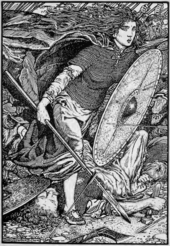Shieldmaiden


A shield maiden ( Icelandic skjaldmær , Swedish sköldmö , Danish skjoldmø ) is a woman who has chosen a life as a warrior in Norse mythology .
Women warriors are often mentioned in the sagas such as Hervarar Saga and in the Gesta Danorum . According to the Nordisk familjebok , shield maids also appear in the stories of other Germanic nations - Goths , Cimbri and Marcomanni - and were the role models for the Valkyries .
In Scandinavian sagas are considered armed, fighting women under other Brynhild in Völsunga saga , emphasis in the Hervarar Saga , the Brynhild of Bosa Saga OKS Herrauds and the Swedish princess Thornbjörg in Hrólfs Saga Gautrekssonar mentioned by name, as in the Gesta Danorum of Saxo Grammaticus Weghbiorg (Wegthbiorg), Rusla and Lathgertha , the first wife of Ragnar Lodbrok . According to Saxo Grammaticus, under the leadership of the three battle maids Webiorga (Webiorg, Veborg), Wisna (Visna) and Hertha (Hetha, Hed), three armies from countries outside Denmark fought on the Danish side in the Battle of Bråvalla . Saxo describes in his seventh book how women seized the life as warriors in order to avoid marriage. In Ragnars saga loðbrókar it is Aslaug who accompanies her sons on military expeditions several times and is therefore given the new nickname Randalin ("Shield Maiden").
Reception in literature
JRR Tolkien was inspired by the Nordic legends. In his novel The Lord of the Rings , Éowyn is described as a shieldmaiden (shieldmaiden) .
literature
- Edmund Mudrak (ed.): Nordic gods and heroic sagas . Ensslin & Laiblin Verlag, Reutlingen 1961, S 291. Schildmaid, Schildjungfrau. Fighter armed like a man […].
- Matthias Egeler: Valkyries, Bodbs, Sirens. Thoughts on the religious-historical connection of northwest Europe to the Mediterranean region . Walter de Gruyter, Berlin 2011. On Brynhild, Schildmaiden: p. 53 ff .; Valkyries, shield maids and sexuality: p. 84 ff. ( Preview of the book on Google Books ).
- Sköldmö . In: Theodor Westrin, Ruben Gustafsson Berg, Eugen Fahlstedt (eds.): Nordisk familjebok konversationslexikon och realencyklopedi . 2nd Edition. tape 25 : Sekt – Slöjskifling . Nordisk familjeboks förlag, Stockholm 1917, Sp. 1372 (Swedish, runeberg.org ).
Individual evidence
- ↑ Gesta Danorum 8.4.6 (p 219.10). (1) Eodem test puella Weghbiorg in hostem dimicans Soti pugilem acie stravit .
- ↑ a b c d e Explanations of the first nine books of the Danish history of the Saxo Grammaticus, Part I, Books VI – IX - German translation on Wikisource
- ↑ Gesta Danorum 8.7.5 (p 222.37). (1) Eodem tempore Rusla virgo, strenuis militiae operibus muliebrem animum supergressa, apud Norvagiam cum fratre Throndo crebros de rerum summa conflictus habuerat .
- ↑ Gesta Danorum 9.4.2 (p 251.30). (1) Inter quas affuit et Lathgertha, perita bellandi femina, quae virilem in virgine animum gerens, immisso humeris capillitio, prima inter promptissimos dimicabat .
- ↑ Gesta Danorum 8.2.4 (p 214.24). (2) Webiorgam quoque, eodem spiritu praeditam, Bo Brami filius et Brat Iutus belligerandi cupidine prosequuntur .
- ↑ Gesta Danorum 8.2.5 (p 214,30). (1) Wisnam vero, imbutam rigore feminam reique militaris apprime peritam, Sclava stipaverat manus, cuius praecipui Barri ac Gnizli satellites agnoscuntur .
- ↑ Gesta Danorum 8.2.6 (p 215.5). (1) At Hertha, promptissimis stipata comitibus, armatam bello centuriam afferebat .
- ↑ Gesta Danorum 7.6.8 (p 192.12). (1) Et ne quis hunc bellis sexum insudasse miretur, quaedam de talium feminarum condicione et moribus compendio modicae digressionis expediam. (2) Fuere quondam apud Danos feminae, quae formam suam in virilem habitum convertentes omnia paene temporum momenta ad excolendam militiam conferebant, ne virtutis nervos luxuriae contagione hebetari paterentur. (3) Siquidem delicatum vivendi genus perosae corpus animumque patientia ac laboratories durare solebant totamque femineae levitatis mollitiem abdicantes muliebre ingenium virili uti saevitia cogebant. (4) Sed et tanta cura rei militaris notitiam captabant, ut feminas exuisse quivis putaret. (5) Praecipue vero, quibus aut ingenii vigor aut decora corporum proceritas erat, id vitae genus incedere consueverant. (6) Hae ergo, perinde ac nativae condicionis immemores rigoremque blanditiis anteferentes, bella pro basiis intentabant sanguinemque, non oscula delibantes armorum potius quam amorum officia frequentabant manusque, quas in telas aptare exhibo debuerant, telorum obsequiis non-student debuerant, sedo obsequiis spiculis appeterent, quos mulcere specie potuissent. (7) Nunc a deverticulo propositum repetam .
- ^ Friedrich Heinrich von der Hagen (editor and translator): Ragnar-Lodbroks-Saga, and Norna-Gests-Saga . Verlag Joseph Max und Komp., Breslau 1828, Saga of Ragnar Lodbrok and his sons , Chapter 11, p. 59 ( digitized in the Internet Archive ).
